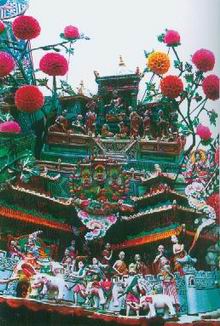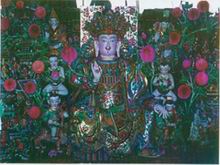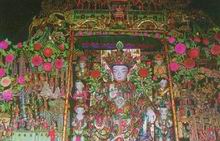The butter sculpture

Butter sculptures
originated in the Tar Monastery in Qinghai Province. They form
a kind of carving art, but the material used is butter mixed with
mineral colors. The Tibetans think those who pay sacrifices to
Buddha and Buddhist guardians will enjoy peace and happiness.
Butter is a favorite kind of food of the Tibetans. It takes the
yellowish white color, and can be used to make different kinds
of sculptures. Legend has it that, in 641 when Tubo King Songtsan
Gambo won the hand in marriage of the Tang Dynasty Princess Wencheng,
she entered Tibet with a statue of Sakyamuni as tall as he was
at the age of 12. It was enshrined in Jokhang Monastery in Lhasa.
Objects used as sacrifices to the statue of Buddha included fresh
flowers, aromatic materials, holy water, incense, fruit and Buddhist
lamps. As no fresh flowers were available in winter, artificial
ones molded from butter became a substitute. 
According to the tour guide who showed us around the Tar Monastery,
Tsongkapa, founder of the Gelug Sect of Tibetan Buddhism who was
born in the Tar Monastery, once had a dream of grass turning into
lamps shining brightly among the flowers that evolved from thorny
plants. When he woke up, he asked monks to reproduce what he saw
in the dream with butter and used the results to worship statues
of Buddha on the evening of the mid-month day. This is why butter
sculptures had to be burned up before it dawned right up to the
1950s.
Butter sculptures assume endless shapes. They include images
of Buddha, ancient ministers, and even flowers, birds, fish and
insects, and pavilions. They are created generally to illustrate
a story. When a large butter sculptures show is organized, the
exhibits often tell a number of connected stories. Cases in point
include Stories of the Life of Sakyamuni, and Princess Wencheng.
The latter is composed of close to 300 figures and with Chang'an
(present-day Xi'an), Sun-Moon Mountain, sources of rivers and
Lhasa as the backdrop. 
Given the complicated workmanship, efforts have to be made from
October to January to create the sculptures. First of all, the
artisans need to dip butter into ice water and rub it to remove
any dregs. Before making butter sculptures, the monk artisans
need to perform a ritual that includes the recitation of an oath.
When this is over, the lama in charge of measuring will join with
other artisans to decide upon the theme of the butter sculptures.
The work itself is carried out in rooms where the temperature
is sub-zero.
First of all, they make frameworks using leather, ropes and bamboo
chips as molds.
Secondly, they mix butter left behind from the previous year's
project with straw ash, and then mould the different figurines.
The lamas in charge of measuring will then check the size of the
sculptures.
Next, white butter is mixed with mineral colors and the mixture
is used to paint the molded figurines.
Finally, the sculptures are linked up with iron wire to the place
where they should stand to highlight the set theme.
In a group of butter sculptures, a pavilion, a Buddha or an arhat
may be as high as several meters; and a flower, a bird, an insect
and a fish may be as small as three to five centimeters. All of
them are lifelike.
All butter sculptures stand with a forward angle of 20 degrees
Centigrade to facilitate viewing, and make it possible for the
butter sculptures to melt from top to bottom. Generally, they
need to be remade in one or two years.
As butter sculptures are all made in sub-zero temperature environment,
deformities begin appearing above 15 degrees Centigrade and they
begin to melt at 25 degrees Centigrade. With a view to guaranteeing
the quality, monk artisans need to dip their hands in freezing
water from time to time. This is why they tend to suffer from
arthritis and some become crippled. Their contribution to Buddhism
is really incredible.
The Tar Monastery has two groups charged with making butter sculptures.
The first group is called the Upper Sculptures Group and the second
the Lower Sculptures Group. The members compete with each other
and each group works under a confidential environment for three
months. None of the group members, totaling about 30, will venture
to leak their secret to their opponents. The best work will be
selected for public appreciation.
page
up page down |



